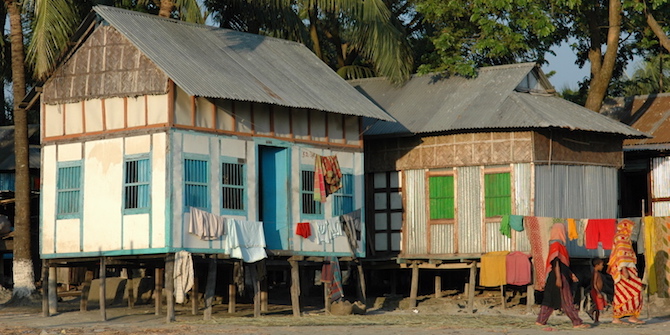Could over one million people in Assam be on the verge of being effectively locked outside India’s social benefit architecture? Silvia Masiero (Loughborough University) reflects on the prospects for those excluded from the final National Register of Citizens (NRC) in Assam and how they could become ineligible for Aadhaar – the Government’s digital identification project linked to access to welfare services.
The exclusion of a massive number of individuals from the final National Register of Citizens (NRC) published on 31 August raised many pressing questions. One of these questions that has dominated much of the conversation in India over the last week is what will it mean for more than 1.9 million people in the northeastern state of Assam set to be excluded from the final NRC list?. Contrasting statements have been made on the matter, a large number of which point to the risk of statelessness for those excluded from the list. Among others, the United Nations High Commissioner for Refugees (UNHCR) has expressed concern for the situation, urging the Indian government to “take steps that mitigate the risk of any individual being left stateless.”
Let’s begin with the NRC which is a register containing details of individuals recognised as Indian citizens. The first NRC was prepared in 1951 based on that year’s Census, and has recently been updated only in Assam – a state with a long history of immigration, featuring movements (epitomised by the Assam All Students Union – AASU) that in fact opposed immigration through the years. The NRC is currently being updated following the Assam Accord (1985) that marked the end of a six-year agitation movement against migrants from Bangladesh – formerly East Pakistan. The Assam Accord, signed from representatives of the Assam Movement and of the Governments of India and Assam in the presence of the then Prime Minister Rajiv Gandhi, stated that foreigners who came to Assam after 24 March 1971 were to be “detected, deleted and expelled” in accordance with the law.
The criteria for inclusion in the NRC are based on an individual, or one of their ancestors, needing to have their names in the 1951 NRC or in the electoral rolls up to 24 March 1971. Alternatively, individuals can produce a document from a list of 12 different items, including a birth certificate, a land or tenancy record, a passport, a refugee registration certificate or a permanent residential certificate. The NRC update has placed the burden of retrieving documents on the shoulders of residents, who have had to produce such documents to be considered for inclusion in the final NRC. Exclusion implies non-recognition of the status of citizens, a decision that can be appealed (in a limited time frame) to Foreigners Tribunals in the courts, whose rigour however has been questioned by multiple voices in the public debate.
Images of people queuing to check their status look out of place when compared to India’s digital identification project Aadhaar, which the Government regularly uses as an example of its own effectiveness. Launched in 2010, Aadhaar provides “voluntarily” enrolled residents with a 12-digit unique identity number, linked to their biometric and demographic data, which is then stored in a database managed by the Unique Identification Authority of India (UIDAI). The Targeted Delivery of Financial and Other Subsidies, Benefits and Services Act (Aadhaar Act) 2016 links Aadhaar to welfare delivery, backing its incorporation in India’s social protection schemes. While widely represented as a governance success, its nature as a requirement for social protection has led to concerns of social justice, due to the burden of authentication failure and importantly, to the confinement of social protection entitlements to those residents who “chose” to enrol.
On the eve of publication of the NRC on 31 August, India Today cited a senior Home Ministry official reporting that “the biometric data taken during the process of claims of the NRC will ensure that those who are in the final NRC will get Aadhaar and those who could not prove their Indian citizenship will not get it anywhere in the country,” as their biometrics will be “flagged” as those of foreigners. If put into action, this statement implies that the more than 1.9 million residents in Assam excluded from the final NRC (specifically, those whose potential appeals to Foreigners Tribunals) will be barred from Aadhaar enrolment, remaining effectively locked outside India’s social benefit architecture other than from Indian citizenship. Yet, this statement raises questions on at least two topics.
First, while inclusion or exclusion in the NRC impacts upon the citizenship of an individual, Aadhaar enrolment is based on the proof of residency, and is not linked to a citizenship attribution; neither does the Aadhaar card constitute proof of citizenship. The Aadhaar Act states that “every resident shall be entitled to obtain an Aadhaar number by submitting his demographic information and biometric information”. Documents valid for enrolment refer to proof of identity (POI), proof of family relationship (POR), date of birth (DOB) and proof of address (POA), while Indian citizenship never featured as a requirement. As a result the idea of barring people from Aadhaar enrolment on the grounds of inability to prove citizenship, as opposed to residency, remains to be explained.
Second, it is important to understand the infrastructural basis on which the “flagging” of biometric data of people excluded from the NRC may take place. It has been reported that UIDAI had offered “technical support” to the Government of Assam to build a biometric register of residents excluded from NRC. But the nature and extent of such support is unclear, and so is the form of data protection that applies to the biometric and demographic details collected under such an exercise (India has not yet enacted a data protection law, and is not a party of international conventions on data protection). If the “flagging” of individuals excluded from NRC to UIDAI is to be based on interoperability among the two databases, identification of those who failed to get citizeship (which, again, is not a requirement for Aadhaar) may take place in the absence of a proper data protection system.
Assam is a unique case for Aadhaar, since enrolment in the database, which boomed throughout the country shortly after launch in 2010, has been held off until the updating of the NRC. This results in the lowest Aadhaar saturation rates in the country, given the very recent establishment of enrolment centres for registering within the state’s borders. Making Aadhaar a precondition for accessing social welfare means denying such welfare to those excluded, of which those left outside the NRC are to be a part if the statement is to be put into action. On top of the risk of statelessness already borne by this wide group of people, a new layer of exclusion from social welfare provision might be underway.
This article gives the views of the author, and not the position of the South Asia @ LSE blog, nor of the London School of Economics. Please read our comments policy before posting. Featured image: Cloud memory. Credit: Geralt, Pixabay.







